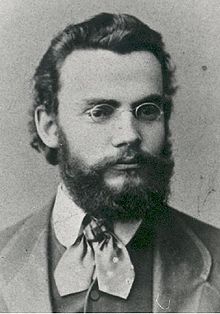Estonian national awakening
| History of Estonia |
|---|
 |
| Chronology |
|
|
The Estonian Age of Awakening (
Republic of Estonia in 1918. The term is sometimes also applied to the period around 1987 and 1988.[1]
History

Although Estonian national consciousness spread in the course of the 19th century,Imperial Russia remained positive.[3]

In 1881 seventeen Estonian societies, in a memorandum inspired by Carl Robert Jakobson, called upon Emperor
Baltic Provinces 10 years and older, roughly equally for males and females).[3][5] The cities became Estonicized quickly, and in 1897 ethnic Estonians comprised two-thirds of the total Estonian urban population.[3]
In response to a period of
Soviet Russia
, Estonia declared itself an independent nation on 24 February 1918.
See also
- Baltic Germanmovement that led to and promoted the Estonian national awakening
- Finnish Nationalism
- The First Latvian National Awakening
- Lithuanian national awakening
References
- ^ Kutsar, D. (1995). "Social change and stress in Estonia" . International Journal of Social Welfare 4.2, pp. 94–107.
- ^ Gellner, Ernest (1996). "Do nations have navels?" Nations and Nationalism 2.2, 365–370.
- ^ a b c d Raun, Toivo U. (2003). "Nineteenth- and early twentieth-century Estonian nationalism revisited" . Nations and Nationalism 9.1, 129–147.
- ^ Ariste, Paul (1956). "Maakeel ja eesti keel". Eesti NSV Teaduste Akadeemia Toimetised 5: 117–124.
- ISBN 3-406-47573-6
- ^ Raun, Toivo U. (1984) The Revolution of 1905 in the Baltic Provinces and Finland. Slavic Review 43.3, 453–467.
Further reading
- Petersoo, Pille (2007). Reconsidering otherness: Constructing Estonian identity. Nations and Nationalism 13.1, 117–133.
- Raun, Toivo U. (2003). Nineteenth- and early twentieth-century Estonian nationalism revisited. Nations and Nationalism 9.1, 129–147.
- Raun, Toivo U. (1986). The Latvian and Estonian national movements, 1860–1914. The Slavonic and East European Review 64.1, 66–80.
- Piirimäe, Helmut. Historical heritage: the relations between Estonia and her Nordic neighbors. In ISBN 9985-56-257-7
- Nodel, Emanuel. Estonia: Nation on the Anvil. N.Y.: Bookman Associates, 1963.
- Raun, Toivo U. Estonia and the Estonians. 2nd ed. Stanford, CA: ISBN 0-8179-9131-X
